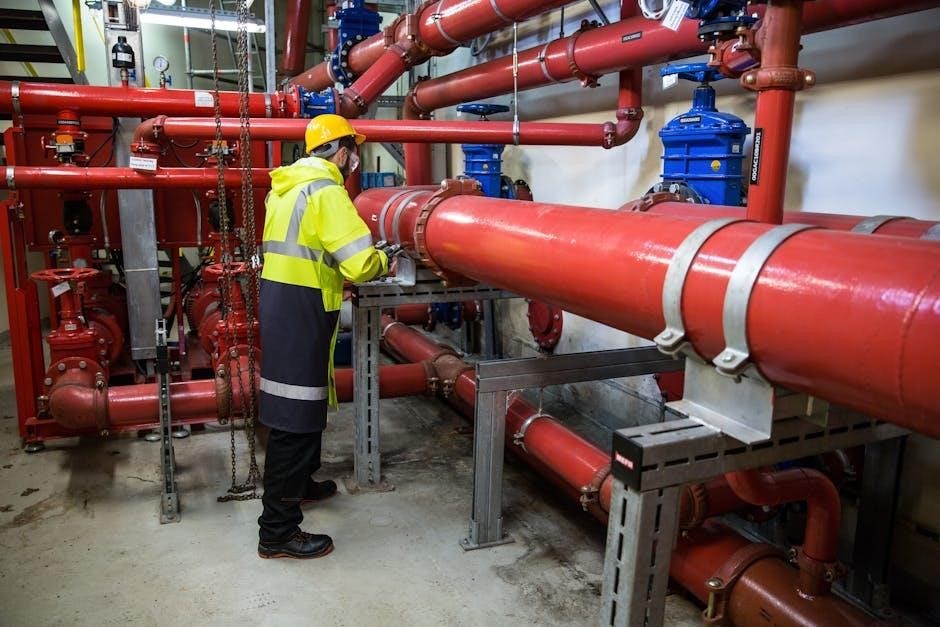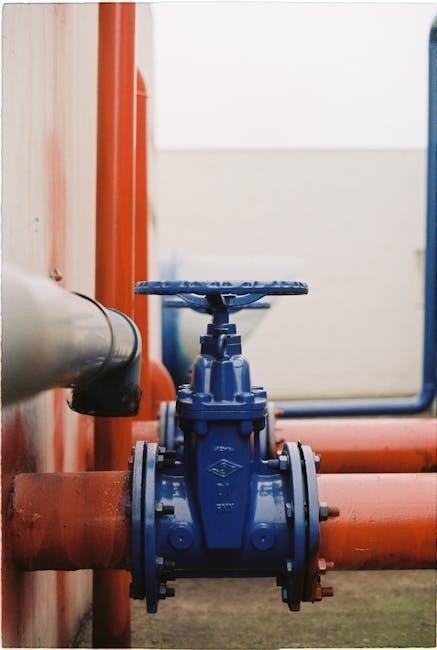valve guides and seals

Valve guides and seals are critical engine components ensuring proper valve operation. Guides align valve stems, while seals prevent oil leakage. Their durability directly impacts engine performance and efficiency.
- Guides and seals work together to maintain valve train integrity.
- Proper function prevents oil leakage and reduces emissions.
- Deterioration can lead to decreased performance and increased maintenance costs.
1.1 Overview of Valve Guides and Seals
Valve guides and seals are essential components in an engine’s valve train system. Valve guides align the valve stems, ensuring proper movement and preventing misalignment. Seals, on the other hand, are responsible for preventing oil leakage around the valve stems. Together, they maintain engine efficiency, reduce emissions, and prevent oil from entering the combustion chamber or exhaust system. Valve guides are typically made from durable materials like steel or bronze, while seals are often rubber or polymer-based. Proper installation and maintenance are crucial to avoid premature wear. Over time, wear and tear can lead to oil leakage, smoke emissions, and reduced engine performance. Regular inspection and replacement are vital to sustaining optimal engine functionality.
- Valve guides ensure accurate valve stem alignment.
- Seals prevent oil leakage, maintaining engine efficiency.
- Durable materials are used to extend component lifespan.
- Failure can result in oil leakage and performance issues.
1.2 Importance in Engine Performance
Valve guides and seals play a crucial role in maintaining optimal engine performance. They ensure proper valve operation, preventing oil leakage into the combustion chamber and minimizing emissions. When functioning correctly, they enhance engine efficiency, reduce fuel consumption, and prevent performance issues like power loss or rough idling. Faulty guides or seals can lead to oil contamination in the intake or exhaust systems, causing blue-gray smoke during startup or idle. This not only reduces engine lifespan but also increases maintenance costs. Their reliability is vital for sustaining smooth operation, thermal efficiency, and overall engine health. Regular monitoring and timely replacement are essential to avoid severe damage and maintain peak performance.
- Prevent oil leakage into combustion chambers.
- Enhance engine efficiency and fuel economy.
- Minimize emissions and environmental impact.
- Prevent performance issues like power loss.
- Ensure smooth and reliable engine operation.

Components of Valve Guides and Seals
Valve guides and seals are made from durable materials like bronze or steel for guides and Viton or rubber for seals, ensuring longevity and leak-free performance.
- Guides: Typically made from bronze or steel for strength and durability.
- Seals: Often constructed from Viton or rubber for superior sealing properties.
2.1 Valve Guides: Materials and Design
Valve guides are typically made from durable materials such as bronze or steel, chosen for their strength and resistance to wear. The design ensures proper alignment of the valve stem, minimizing lateral movement and preventing excessive wear. A smooth surface finish, often with a roughness average (RA) of around 0.15 microns, is critical for optimal performance. Some guides feature barbed ends to securely hold valve seals in place, particularly for intake valves. Proper clearance between the guide and valve stem is essential to prevent overheating and ensure smooth operation. The design also incorporates features to prevent oil leakage, as worn guides can allow oil to seep into combustion chambers, leading to smoke and reduced efficiency.
- Bronze and steel are common materials for valve guides due to their durability.
- A smooth surface finish, such as 0.15 microns RA, is vital for performance.
- Barbed ends on intake valve guides help secure seals effectively.
- Proper guide-to-stem clearance prevents overheating and wear.
2.2 Valve Seals: Types and Functions
Valve seals are essential for preventing oil leakage around the valve stem. They come in various types, including rubber and non-rubber designs. Rubber seals are widely used for their flexibility and sealing efficiency, while non-rubber types offer durability and resistance to high temperatures. The choice of seal depends on the engine’s specifications and operating conditions. Proper installation ensures minimal oil seepage, reducing smoke during startup and idle. Worn seals can cause oil to enter the combustion chamber, leading to blue-gray smoke. Regular inspection and replacement are crucial for maintaining engine health and performance. The seals work in conjunction with valve guides to ensure a tight seal, preventing oil from compromising the engine’s efficiency and emissions.
- Rubber seals provide flexibility and effective sealing.
- Non-rubber seals offer durability and heat resistance.
- Proper installation minimizes oil leakage and smoke.
- Worn seals can cause oil entry into combustion chambers.

Installation and Replacement
Valve guides and seals require precise installation to ensure proper engine function. Using tools like a valve spring compressor, install new components to prevent oil leakage and maintain efficiency.
- Valve spring compressor is essential for safe replacement.
- Ensure proper alignment to avoid damage during installation.
- Prevent oil leakage by seating seals correctly.
3.1 Tools Required for Replacement
Replacing valve guides and seals demands specialized tools to ensure accuracy and safety. A valve spring compressor is essential to relieve spring tension, while a guide installer and seal installer facilitate proper component seating. Pliers may be needed for removing old seals, and a micrometer helps measure clearances. A cleaning kit ensures the area is free from debris, crucial for preventing damage during installation. Additionally, a Schley tool is often recommended for intake valve stem seal replacement, as mentioned in various forums. Proper tools ensure a professional-grade replacement, minimizing risks of engine damage.
3.2 Step-by-Step Installation Process
Installing valve guides and seals involves precise steps to ensure proper function. Begin by removing the valve spring using a valve spring compressor to relieve tension. Next, extract the old guide using a guide puller or similar tool. Clean the area thoroughly before installing the new guide, ensuring it is properly seated. For seals, apply a thin layer of engine oil to the valve stem and slide the seal into place using a seal installer; Reassemble the spring and retainer, then repeat for all valves. Finally, perform a leak-down test to confirm proper sealing. Proper alignment and torque specifications are critical for long-lasting performance.
3.3 Common Mistakes to Avoid
When replacing valve guides and seals, several common mistakes can lead to poor performance or further damage. One major error is using improper tools, such as incorrect-sized drifts or compressors, which can damage the valve train. Another mistake is installing the wrong type of seal, which may not provide a proper fit or lasting durability. Additionally, failing to clean the area thoroughly before installation can lead to contamination and premature wear. Over-tightening or under-tightening components is also a common issue, as it can disrupt proper alignment and sealing. Lastly, rushing the process without following precise torque specifications can result in uneven wear or leakage. Avoiding these pitfalls ensures a successful repair and optimal engine performance.
3.4 Post-Installation Checks
After installing new valve guides and seals, it is crucial to perform a series of checks to ensure proper functionality. Start with a visual inspection to confirm all components are correctly aligned and seated. Next, conduct a smoke test to detect any internal leaks, especially around the valve area. Additionally, check for oil leakage by monitoring the engine for blue-gray smoke during startup or acceleration. A vacuum test can also help identify if the seals are holding properly. Finally, take the vehicle for a test drive under various conditions to assess performance and ensure no unusual noises or smoke appear. These post-installation checks are essential for verifying the repair’s success and ensuring long-term engine health.

Symptoms of Faulty Valve Guides and Seals
Faulty valve guides and seals cause blue-gray smoke on startup and acceleration due to oil leakage. Oil residue on valves after idling indicates worn seals.
4.1 Common Symptoms of Failure
Common symptoms of faulty valve guides and seals include blue-gray smoke during startup or acceleration, indicating oil leakage into combustion chambers. Oil residue on valves after idling is another sign. Increased oil consumption and decreased compression can also occur. Over time, this leads to reduced engine performance and efficiency.
- Blue-gray smoke during engine operation.
- Oil droplets on the underside of the valve.
- Increased oil consumption without visible leaks.
- Decreased engine compression and power.
These issues highlight the importance of early detection to prevent further engine damage.
4.2 Diagnosing Issues with Smoke Tests
Smoke tests are a reliable method for diagnosing valve guide and seal issues. Blue-gray smoke during engine operation, especially after idling or acceleration, often indicates oil leakage through faulty seals. Mechanics may perform a road test to observe smoke patterns, which can confirm the presence of worn components. Visual inspection using a camera down the manifold can also identify oil residue on valves, providing clear evidence of failure. These tests are essential for pinpointing the source of oil leakage and determining the extent of repair needed. Early detection through smoke tests can prevent further engine damage and costly repairs.
- Blue-gray smoke during engine operation.
- Oil residue visible on valves during inspection.
- Smoke tests confirm worn guides or seals.
4.3 Differentiating Valve Guide vs. Seal Problems
Differentiating between valve guide and seal issues is crucial for accurate diagnosis. Valve guide problems typically result from wear, causing misalignment and excessive valve stem movement. This leads to poor engine performance, reduced compression, and potential damage to other components. In contrast, seal failures usually manifest as oil leakage, often visible as blue-gray smoke during engine startup or idle. While guides affect valve alignment, seals prevent oil from entering combustion chambers. Identifying these distinct symptoms helps pinpoint the root cause. Smoke tests are particularly effective for diagnosing seal issues, as oil leakage produces visible emissions. Understanding these differences ensures targeted repairs, avoiding unnecessary replacements and maintaining engine efficiency.
- Valve guide wear leads to misalignment and performance issues.
- Seal failure results in oil leakage and visible smoke.
- Smoke tests are key for identifying seal-related problems.

Maintenance and Care
Regular cleaning with solvents and lubrication during replacement prevents wear. Inspections should focus on detecting early signs of wear or oil leakage to ensure optimal performance and longevity.
- Clean valve guides with solvents to remove debris.
- Lubricate seals during installation to reduce friction.
- Inspect for wear or oil leakage regularly.
5.1 Cleaning Methods for Valve Guides
Cleaning valve guides is essential for maintaining proper engine performance. Use solvents to remove dirt and carbon buildup, then dry thoroughly with compressed air. Avoid abrasive materials that could damage the surface. For stubborn deposits, a soft-bristle brush can gently scrub the area without causing harm. Regular cleaning prevents oil residue from hardening and ensures smooth valve operation. Always inspect guides after cleaning to check for wear or damage. If damage is found, replacement may be necessary to maintain engine efficiency and prevent further issues. Consistent maintenance helps extend the lifespan of valve guides and seals, ensuring optimal engine functionality over time.
- Use solvents to remove dirt and carbon deposits.
- Dry thoroughly with compressed air after cleaning.
- Avoid abrasive materials to prevent surface damage.
5.2 Lubrication Best Practices
Proper lubrication of valve guides and seals is crucial for their longevity and performance. Use high-quality motor oil suitable for your engine type to ensure smooth operation. Apply a thin, even layer of lubricant during installation to prevent friction and wear. Avoid over-lubrication, as it can attract dirt and cause premature degradation. For threaded connections, use Teflon tape or pipe dope to create a secure seal without excess material. Regular lubrication during routine maintenance helps maintain optimal engine efficiency and prevents excessive heat buildup. Always refer to your vehicle’s manual for specific lubrication recommendations tailored to your engine. Proper lubrication practices will extend the life of your valve guides and seals, ensuring reliable engine performance over time.
- Use high-quality motor oil suitable for your engine.
- Apply a thin, even layer of lubricant during installation.
- Avoid over-lubrication to prevent dirt attraction.
- Use Teflon tape or pipe dope on threaded connections.
- Follow manufacturer recommendations for lubrication.
5.3 Regular Inspection Tips

Regular inspections of valve guides and seals are essential for maintaining engine health. Start by checking for signs of oil leakage or smoke, which may indicate worn seals. Inspect valve stems for excessive wear or scoring. Use a compression test to identify potential issues with valve guide integrity. Look for oil residue on the valve stem or guide, as this can signal seal failure. For a more detailed assessment, use a camera to inspect the valve area through the intake manifold. Address any issues promptly to prevent further damage. Regular inspections help detect problems early, ensuring optimal engine performance and longevity.
- Check for oil leakage or smoke during startup or idle.
- Inspect valve stems for wear or scoring.
- Use a compression test to assess valve guide integrity.
- Look for oil residue on valve stems or guides.
- Use a camera for internal inspections.

Technical Specifications
Valve guides and seals require precise technical specifications, including surface finish, material selection, and dimensional tolerances. A polished valve stem with an RA of 0.15 microns ensures optimal performance and durability.
6.1 Surface Finish Requirements
The surface finish of valve guides and seals is critical for proper engine operation. A polished valve stem with a surface roughness (RA) of approximately 0.15 microns is typically recommended. This ensures minimal wear and optimal sealing performance. The finish must be smooth enough to prevent oil from leaking past the seals, while also reducing friction between moving parts. Improper surface finishing can lead to premature wear, increased oil consumption, and reduced engine efficiency. Manufacturers often specify strict tolerances for surface finish to maintain reliability and longevity of the valve train components. Adhering to these specifications is essential for ensuring consistent engine performance and minimizing maintenance costs over time.
6.2 Clearance and Tolerances
Proper clearance and tolerances in valve guides and seals are essential for efficient engine operation. Excessive clearance can lead to oil leakage and increased wear, while insufficient clearance may cause overheating and seizure. Typically, valve stem-to-guide clearance ranges between 0.0015″ to 0.0035″ for most engines. Tighter tolerances are preferred to minimize oil consumption and reduce emissions. However, clearances must also accommodate thermal expansion during engine operation. Manufacturers provide specific tolerance ranges to ensure optimal performance and longevity of the valve train. Maintaining these tolerances during installation and repair is crucial to prevent premature failure and ensure reliable engine function. Proper measurement tools and techniques are necessary to achieve accurate clearances and tolerances.

Cost and Replacement Considerations
The cost of replacing valve guides and seals averages between $300 to $1,500, depending on labor, parts, and complexity. Factors like engine type, tool requirements, and additional repairs influence the total expense. Skilled labor is often necessary for precise installation, adding to the overall cost. Replacement is crucial to prevent further damage and maintain engine efficiency.
7.1 Average Cost of Replacement

The average cost to replace valve guides and seals ranges from $300 to $1,500, depending on the vehicle and extent of damage. Labor costs typically dominate, averaging $200-$800, while parts cost $100-$700. High-performance or specialized engines may incur higher costs. Additional repairs, such as replacing damaged valves or guides, can increase the total expense. Factors like engine accessibility and the need for specialized tools also influence pricing. In some cases, replacing the entire cylinder head may be necessary, raising costs further. It’s essential to consult a mechanic for an accurate estimate tailored to your vehicle’s specific needs. Proper installation ensures long-term reliability and prevents future issues.
7.2 Factors Affecting Cost
Several factors influence the cost of replacing valve guides and seals. The type and brand of parts chosen significantly impact expenses, with high-quality components costing more. Labor rates vary by region and mechanic expertise, affecting overall costs. Additionally, the extent of damage dictates whether only seals or both seals and guides need replacement. Engine complexity, such as in turbocharged or diesel engines, can increase labor time and costs. Accessory removal, like intake manifolds, may also add to the bill. Some vehicles require specialized tools, further raising expenses. Diagnostic fees and additional repairs, such as cylinder head resurfacing, can also contribute. These variables make it essential to obtain detailed estimates from professionals to understand the full financial commitment involved in the repair.

Case Studies and Real-World Applications
Real-world scenarios highlight valve guide and seal failures, often causing oil leakage and smoke. Successful replacements, like intake valve stem seal fixes, demonstrate improved engine performance and reduced emissions. Tools such as valve spring compressors and camera inspections aid in precise diagnoses. These case studies emphasize the importance of proper installation and material selection to prevent future issues. They also underscore the financial and operational benefits of timely repairs, avoiding costly engine damage. By analyzing these applications, mechanics and enthusiasts gain insights into common problems and effective solutions, ensuring optimal engine functionality and longevity.
8.1 Successful Replacement Scenarios
A successful valve guide and seal replacement was documented in a case where a vehicle experienced excessive oil consumption and blue-gray smoke upon startup. The issue was diagnosed as worn valve stem seals; Using a Schley tool, the mechanic replaced the seals, resolving the problem and improving engine efficiency. Another scenario involved a driver who noticed oil droplets on the intake manifold. After replacing the valve guides and seals, the engine showed reduced oil leakage and smoother operation. These examples highlight the importance of proper tools and techniques in achieving successful outcomes. Regular inspections and timely replacements can prevent major engine damage, as seen in these real-world applications. Such scenarios demonstrate how addressing valve guide and seal issues can significantly enhance vehicle performance and longevity.
8.2 Lessons Learned from Common Failures
Common failures of valve guides and seals often stem from improper installation techniques. One major issue is insufficient use of lubrication during replacement, leading to premature wear. Another is ignoring surface finish requirements, which can cause oil leakage. Mechanics have learned that using the correct tools, like the Schley tool, is crucial for avoiding damage to the valve train. Additionally, neglecting regular inspections can result in prolonged engine damage. For instance, drivers who overlook blue-gray smoke during startups often face costly repairs. These experiences emphasize the importance of adhering to technical specifications and best practices. By addressing these common pitfalls, technicians and drivers can extend the lifespan of their engines and maintain optimal performance. Proper maintenance and timely replacements remain key to avoiding these issues.
Valve guides and seals are vital for engine efficiency and longevity. Proper maintenance, timely replacements, and adherence to technical specifications ensure optimal performance and prevent costly repairs.
9.1 Summary of Key Points
Valve guides and seals are essential components that ensure proper engine operation by preventing oil leakage and maintaining valve alignment. Guides are typically made from durable materials, while seals come in various types to suit different engine needs. Proper installation and regular maintenance are critical to prevent wear and tear. Common symptoms of failure include oil leakage, smoke emission, and reduced engine performance. Diagnostics, such as smoke tests, help identify issues early. Regular inspections, cleaning, and lubrication extend component lifespan. Understanding technical specifications and adhering to best practices during replacement are vital for optimal results. Addressing problems promptly avoids costly repairs and ensures long-term engine efficiency and reliability.
9.2 Final Thoughts and Recommendations
Properly maintaining valve guides and seals is crucial for engine longevity and performance. Regular inspections and timely replacements can prevent costly repairs. Using high-quality materials and adhering to manufacturer specifications ensures optimal results. Mechanics should stay updated on best practices and tools for efficient replacements. Vehicle owners are encouraged to address symptoms promptly to avoid severe engine damage. Balancing maintenance costs with long-term benefits is key for sustaining engine health. By prioritizing these components, drivers can enjoy improved fuel efficiency, reduced emissions, and enhanced overall vehicle reliability. Always consult professional guidance for complex repairs to ensure safety and effectiveness.